Circular 683
Carol Sutherland, Jane Breen Pierce, Brad Lewis, and Richard Heerema
College of Agriculture, Consumer and and Environmental Sciences, New Mexico State University
Authors: Respectively, Extension Entomologists, both from the Department of Extension Plant Sciences; College Assistant Professor, Department of Entomology, Plant Pathology, and Weed Science; and Extension Pecan Specialist, Department of Extension Plant Sciences, New Mexico State University. (Print friendly PDF)
In late 2016 and January 2017, pecan weevil was confirmed in several residential locations in southeastern and eastern New Mexico. This publication should answer your questions about the pest and its impacts on commercial pecan producers and homeowners. The second part of the publication should help you understand the current quarantine, contact points for further assistance, and plans for controlling the pest.
What is Pecan Weevil?
- Pecan weevil (Curculio caryae) is a “snout beetle” or “weevil.” It is considered the worst and most destructive insect pest of pecan and hickory nuts in North America.
- Pecan weevil is native to the eastern U.S. and parts of the Midwest, but NOT New Mexico.
- Pecan weevil is not only a destructive pest of pecan nuts but also secretive and well camouflaged.
What Does Pecan Weevil Look Like?
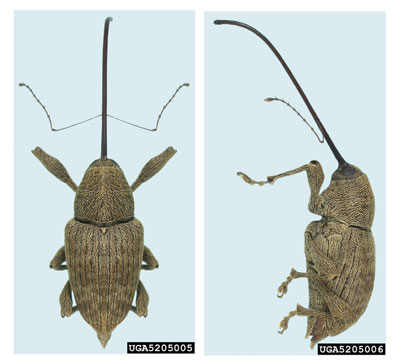
Figures 1 (left) and 2 (right). Adult female pecan weevil (Natasha Wright, Cook’s Pest Control, Bugwood.org ).
- Adult pecan weevils are tan to grayish-brown beetles, 3/8 to about 1/2 inch long with extremely long, very slender, curved snouts. The snout on the female is longer than her body (Figures 1 and 2), while that of the male is only about half the length of his body. Adults have two pairs of wings; the hind wings resemble a membrane and are about half the length of the adult’s body.
- Pecan weevil larvae are legless, plump, and creamy white, and their bodies have multiple segments. Mature larvae may be about 1/3 to a little over 1/2 inch long. They have reddish-brown head capsules and chewing jaws (Figure 3).
- In terms of familiar objects, adult pecan weevils and mature larvae are about the size of a shelled peanut.
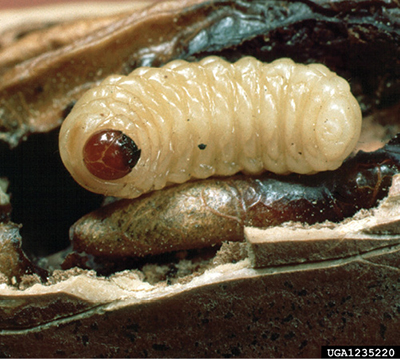
Figure 3. Pecan weevil larva (Clemson University, USDA Cooperative Extension Slide Series, Bugwood.org).
Why is Pecan Weevil Important?
- In 2015, over 2,000 New Mexico farms were involved in commercial pecan production, and produced pecan nuts worth more than $180 million, ranking first in the state for cash receipts from agricultural crops. New Mexico accounted for almost one third of the pecans produced in the U.S. Pecans are increasingly important sources of farm income for New Mexico producers and revenue for the state.
- If pecan weevil becomes established in the state’s commercial orchards, it would cause increased insecticide applications, increased production costs, reduced on-farm revenue, and a perceived reduction in the state’s reputation for high-quality pecans.
- Certified organic pecan orchards would be particularly impacted by pecan weevil establishment because there are few effective control measures available.
- If you have even one pecan tree, even if it is in your yard and not an orchard, you are part of this industry. What infests your trees and what you do about it can support the industry or—in the case of pecan weevil—damage it.
- Unless you carefully inspect your pecan nuts every year, both marketable and trash or cull nuts, you may not realize you are harboring this destructive pest.
Why is Pecan Weevil Considered a Major Pest of Pecan?
- Pecan weevil adults emerge from the soil to feed on and lay eggs in nuts over several months. This prolonged emergence period, the need for multiple insecticide applications, difficulty in finding adult pecan weevils, direct feeding on maturing nuts, and limited timeframe to apply insecticides for control all contribute to its importance as a significant pecan pest.
- Damaged pecan nutmeats are unfit for human consumption (Figure 4) and must be eliminated before processing. Separating weevil-infested pecan nuts from clean nuts is expensive and adds to a processor’s expense.
- Pecan weevil infestations can reduce nut yields significantly at two points in each growing season. In summer, adult weevils puncture and feed on immature nuts, causing these nuts to fall. Later in the growing season, females lay their eggs (up to six per nut) into larger, more mature nuts. Infested nuts cannot be salvaged.
- The adult stage is the only stage that is susceptible to insecticides. Eggs and larvae develop inside the maturing nuts where insecticides are not effective. Mature larvae emerge from nuts and burrow into the soil, as deep as 2–3 feet. No soil treatments are currently labeled for pecan weevil larvae.
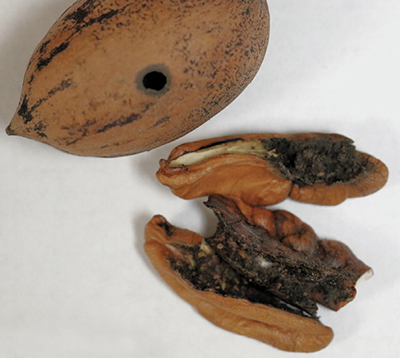
Figure 4. Pecan nuts infested by pecan weevils are not salvageable nor fit for human consumption (Patricia Monk, New Mexico State University).
How is Pecan Weevil Larva Damage Different From Other Insect Pests That Attack Pecan Nuts?
- The other most likely insect to be found inside a pecan nut is the caterpillar stage of the pecan nut casebearer. Unlike pecan weevil feeding, pecan nut casebearer caterpillars make silk strands as they feed on the nutmeat and leave smaller, irregular holes in nutmeats when they emerge (Figure 5). They also leave numerous black granules of waste inside the nut. While these pale gray-green caterpillars are cylindrical and multi-segmented like pecan weevil larvae, pecan nut casebearers have three pairs of short legs on the thorax and five pairs of short, fleshy legs on the abdomen.
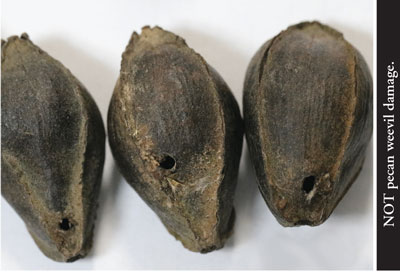
Figure 5. Larvae of pecan nut casebearer leave small, irregular holes in immature pecan nuts. If these nuts are cracked open, strands of silk and black granular caterpillar waste are obvious (Patricia Monk, New Mexico State University).
- Hickory shuckworm larvae are smaller, off-white caterpillars (up to 3/8 inch long) that typically tunnel only in the fleshy pecan shucks. Some of their tunnels may turn black as the shucks mature. While these larvae also produce silk, it may not be that obvious in their tunnels.
- Both pecan nut casebearer larvae and pecan weevil larvae devour nut contents, and both chew exit holes as they leave the pecan nut. Pecan weevil exit holes are almost perfectly round and BB-sized (Figure 6). Pecan nuts infested by either pest are not salvageable.
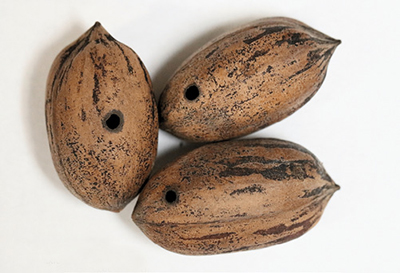
Figure 6. Pecan weevil larva emergence holes in pecan shells (Patricia Monk, New Mexico State University).
- Emergence holes made by pecan weevil larvae are BB-sized, round, and chewed from the inside outward (Figure 6). Holes in nut shells made by birds, especially crows, are much larger, have irregular edges, and are made by beak impacts (Figure 7).
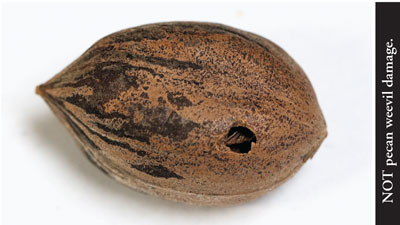
Figure 7. Damage to a pecan shell caused by a bird beak (Patricia Monk, New Mexico State University).
- If you are not sure what insect you are seeing, take an in-focus, close-up digital photo of the insect and attach it to an email sent to your county Extension agent (https://aces.nmsu.edu/county/). You can also put potentially infested nuts in a container in your freezer so your county agent can examine them later. Potentially infested nuts must not be moved out of the quarantine area.
What is the Life Cycle of the Pecan Weevil?
- The pecan weevil life cycle is a “complete metamorphosis” with adult, egg, larva, and pupa stages. The mobile adults occur above ground, but are wary, secretive, and well camouflaged. Eggs are very small and inserted into developing nuts on the tree. Larvae develop inside nuts; they might be seen when nuts are cracked, when mature larvae are chewing through the shell and shuck, or in the bottoms of sturdy containers used to temporarily store gathered nuts. Larvae might also be found by digging underneath the canopies of infested pecan trees. Pupae occur underground from several inches to approximately two feet deep.
- Adult weevils begin to emerge from the soil in late July and will crawl or fly to potential host trees nearby. Young female weevils may feed on immature pecan nuts in the “water stage,” penetrating the shuck and nut with their long, slender snouts tipped with chewing jaws. After feeding on the nutritious liquid endosperm, the female weevil must extract her long, slender snout from the nut, requiring considerable effort. She pulls up on her snout and leverages her body while repeatedly circling the feeding wound. This may create a “bullseye” pattern briefly visible on the green nut shuck (Figure 8). Immature nuts with feeding damage soon fall from the tree.
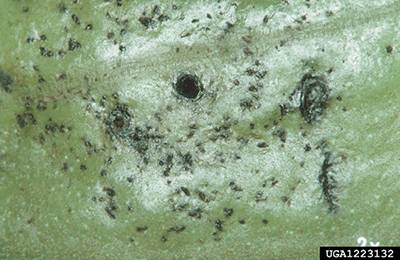
Figure 8. Pecan weevil feeding damage on a pecan nut shuck (Jerry A. Payne, USDA Agricultural Research Service, Bugwood.org).
- Over the next several weeks, male and female pecan weevils continue to emerge from the soil, mature, and mate (Figure 9), while the remaining pecan nuts produce both shells and nutmeats. When her first batch of eggs matures, the female pecan weevil will seek mature pecan nuts, nibble a shallow pit into the shuck, and insert her eggs into the hole, up to six per nut (Figure 10). As her subsequent batches of eggs develop, she can infest 30 or more nuts. Each female may produce as many as 75 eggs over her adult lifetime of about one month. Egg laying continues until shuck split.
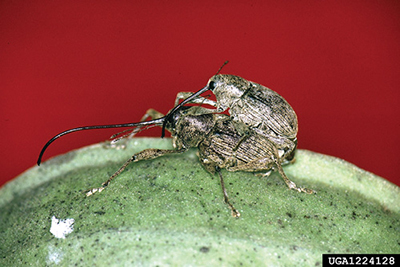
Figure 9. Pecan weevils mating (Jerry A. Payne, USDA Agricultural Research Service, Bugwood.org).
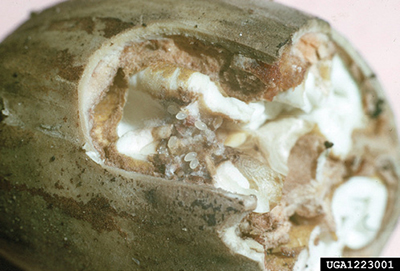
Figure 10. Pecan weevil eggs inside a nut (Louis Tedders, USDA Agricultural Research Service, Bugwood.org).
- Pecan weevil eggs hatch after about a week of development, producing multi-segmented, creamy white, legless larvae (or grubs) with reddish-brown head capsules and chewing jaws. These grubs feed extensively on developing nutmeats (Figure 11), reaching maturity in about 30 days. Then one, or occasionally two, mature larvae in each nut gnaw a round, BB-sized emergence hole that penetrates both nut shell and shuck. The grubs wriggle one at a time through the emergence hole (Figure 12), dropping to the ground and tunneling into the soil, eventually reaching a depth of several inches to a foot or more. Larval emergence from nuts may occur before or after shuck split and before or after harvest.
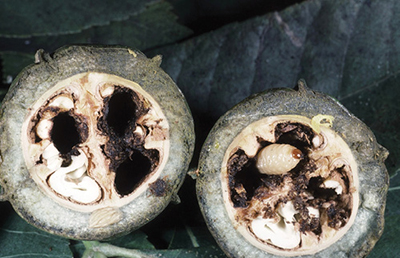
Figure 11. Pecan weevil larvae feeding damage on pecan nuts (Louis Tedders, USDA Agricultural Research Service, Bugwood.org).
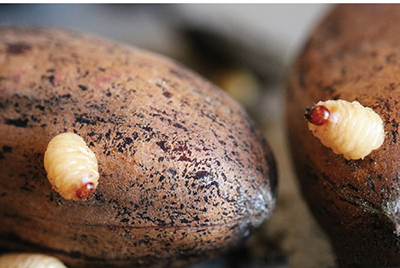
Figure 12. Pecan weevil larvae emerging from pecan nuts (Jane Breen Pierce, New Mexico State University).
- Once in the soil, each grub creates a “cell” (space) around itself in the soil before entering a quiescent (resting) stage for the next year.
- Most of these grubs molt into pupae (transition stage from larva to adult; Figure 13), but do not emerge from the soil as adults until their second year. A portion of pecan weevil larvae delay pupation for two years, emerging from the soil as adults in their third year. Thus, some adult weevils will emerge from the soil every year, with some already two years old and others three years old.
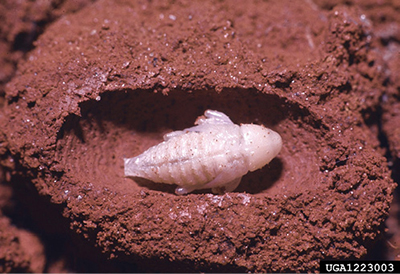
Figure 13. Pecan weevil pupa (Louis Tedders, USDA Agricultural Research Service, Bugwood.org).
When Should I Look For Pecan Weevils?
- Adult pecan weevils are likely to emerge from soil around infested pecan trees from mid- to late July through late September, roughly from the “water stage” of developing nutmeats until “shuck split” before harvest. Adult weevils are well camouflaged and very secretive. Finding them on trunk bark or in the tree canopy is possible, but highly unlikely without the aid of effective traps.
- Pecan weevil larvae can be found inside infested pecan nuts before and after nuts are removed or fall from the tree.
- Larval emergence holes in pecan nut shucks and shells begin to appear in late September and continue as long as larvae are alive. In 2017, nuts collected from residential pecan trees produced live pecan weevil larvae in January.
- While a larval emergence hole through a shuck may be distorted as it dries, removing the shuck will expose the BB-sized, round hole that pecan weevil larvae have chewed through the woody shell.
Where Should I Look For Pecan Weevils?
- In late summer or early fall, adult pecan weevils emerge from the soil and either climb or fly to pecan tree trunks or tree canopies. Unless you have a heavy infestation of adults, finding them is difficult.
- In many instances, owners of pecan trees find either evidence of pecan weevil damage or the redheaded larvae/grubs in a nut. Check both harvested nuts and “stick-tights” where the shuck doesn’t split open to completely release the mature nut. The emergence hole can penetrate the shuck as well as the nut shell.
- Look for BB-sized emergence holes in nut shells and pecan weevil larvae in nuts or storage containers. Bag this evidence, save it in your freezer, and immediately contact your county Extension agent at the Cooperative Extension Service office in your community (https://aces.nmsu.edu/county/).
- Although nuts damaged by pecan weevil can be found in any grade of pecan, they are most often found in lower-grade nuts and stick-tights. Nuts that have been fed on by pecan weevil are normally lighter than undamaged nuts and are often separated at the airleg or pin-roller stages of a cleaning plant.
Where Has Pecan Weevil Been Found?
- Pecan weevil is a native insect throughout most of the Midwest and eastern U.S., wherever pecan or hickory occurs naturally.
- Pecan weevil is not known to be established in New Mexico, California, Arizona, or parts of far West Texas, including El Paso County.
- Over the last 50 years, pecan weevil has periodically been introduced into New Mexico commercial orchards and residential properties in Doña Ana, Luna, and Otero Counties. In all cases, the pest was successfully eradicated.
- In 2016–2017, pecan weevils were confirmed at residences in several communities in Chaves, Eddy, Lea, and Curry Counties. Surveys continue in these and other areas as plans are finalized for weevil eradication. If you suspect your pecan nuts have pecan weevils, SAVE this evidence in your freezer and immediately contact your county Extension agent at the Cooperative Extension Service office in your community (http://aces.nmsu.edu/county/).
How Can Pecan Weevil Be Controlled?
- Any pecan weevil infestation in New Mexico is a major threat to the state’s pecan industry. Pecan weevil infestations must be contained and eradicated as soon as possible so the pest does not become established.
- The New Mexico Department of Agriculture (NMDA) and NMSU’s Cooperative Extension Service are cooperating to facilitate surveys and eradication measures for pecan weevils wherever the pests are confirmed.
- For pecan trees or properties known to be infested with pecan weevil, NMDA has developed proven eradication procedures that require at least six years of supervised and timely insecticide applications, monitoring for adult weevils with various traps, and freezing of all nuts and harvest debris. Pending funding, eradication programs may be conducted cooperatively with growers and homeowners.
What is the Emergency Pecan Quarantine?
The New Mexico Department of Agriculture (NMDA) enacted the Emergency Pecan Weevil Quarantine to prevent pecan weevil-infested pecan nuts from moving out of specific towns—Clovis, Roswell, Hobbs, and Artesia—and into surrounding commercial pecan orchards. The quarantine is state-issued and valid for 60 days, and can be reissued at the end of each 60-day period. Restrictions within the quarantine prevent the movement of in-shell pecans out of the designated city limits without an inspection and issuance of an NMDA inspection certificate. In-shell pecan nuts from pecan weevil-infested trees MUST be treated prior to movement out of the quarantined area.
Is There a Fee for Inspection and for the Certificate?
Due to state statutory requirements, NMDA is unable to waive the fee for inspection certificates (phytosanitary certificates). However, at this time, the pecan industry is paying for this service on behalf of homeowners.
Will Someone Come to My House to See My Tree/Nut Sample?
Every attempt will be made to have someone—your county Extension agent or an NMDA inspector—evaluate your pecan evidence at your home. Priority will be given to residential properties outside of known infested areas within a quarantined city. It is just as important to identify areas that are not infested as it is to identify areas that are infested.
What Should I Do If I Suspect My In-Shell Peans Have Pecan Weevil (Without Breaking Quarantine Regulations)?
- Whether you are INSIDE or OUTSIDE of a pecan weevil quarantine area, if you suspect that your in-shell pecan nuts are infested with pecan weevil, contact your local Cooperative Extension Service office (https://aces.nmsu.edu/county/) who will either visit your location and assess your evidence or will contact an inspector with NMDA on your behalf. If possible, photograph a few holes in your pecans and any larvae/grubs you find feeding in nuts. Send those photos in an email to your county Extension agent asking for assistance with identification.
- NMDA and the Cooperative Extension Service have identified an area in each quarantined town that will be staffed during the harvest season to help residents identify pecan weevil-infested nuts, answer questions, and collect infested nuts. Times and locations will be advertised in each community.
How Can I Preserve the Evidence of Infestation and Where Should I Take It Now?
If you are NOT sure your pecan nuts are infested, collect suspect nuts with holes in them and any associated insects. If possible, photograph your evidence and attach the photos to an email sent to your county Extension agent (https://aces.nmsu.edu/county/) requesting assistance. Since a home visit to assess your evidence may be needed, keep your samples in a sealed container in your home freezer. If your nuts are infested with pecan weevil, see the question about disposal below. Do not move in-shell pecans out of the quarantine area without an inspection certificate issued by NMDA staff.
How Can I (Legally) Dispose of Weevil-Infested Nuts?
Pecan weevil larvae are able to chew through thin plastic and cardboard, so DO NOT discard infested nuts in the garbage OR in your compost pile. Small amounts of infested nuts can be frozen for a week and discarded in the trash or can be buried at least two feet deep in hard-packed dirt. Contact the New Mexico Department of Agriculture (https://www.nmda.nmsu.edu/contact-us/) or the Cooperative Extension Service (https://aces.nmsu.edu/county/) to make arrangements for the disposal of larger amounts of infested pecans.
What Should I Spray and When?
At this time, NMDA and the Cooperative Extension Service are working with the pecan industry, city council representatives, and homeowners on the possibility of an area-wide treatment program to begin in the summer of 2017. If implemented, treatments will be applied by a licensed applicator to residential properties with pecan weevil-infested trees, and to adjacent un-infested trees. Depending on funding, the service will be at no cost to homeowners. If an area-wide program is not implemented, the Cooperative Extension Service will provide recommendations for control by homeowners.
What Should an Accumulator/Buyer Do With In-Shell Nuts That Are Brought From a Quarantined Area Without a Certificate?
If the accumulator/buyer is located out of the quarantined area, we recommend rejecting the nuts, issuing outreach material, and advising the seller to obtain an inspection at the location where the nuts were harvested. Outreach material will be provided to known accumulators/buyers. If the accumulator/buyer is located within the quarantined area, the accumulator/buyer is required to obtain a certificate prior to moving nuts out of the quarantined area.
For further reading
H-618: Growth and Development of Pecan Nuts
https://pubs.nmsu.edu/_h/H618/
H-640: Irrigation Scheduling of Pecan Orchards: Soil Moisture Monitoring
https://pubs.nmsu.edu/_h/H640/
H-657: Diseases and Other Disorders of Pecan in New Mexico
https://pubs.nmsu.edu/_h/h-657/

Carol A. Sutherland is an Extension Entomologist at New Mexico State University and also State Entomologist for the New Mexico Department of Agriculture. Dr. Sutherland makes numerous presentations annually on basic and applied entomology to New Mexico's Master Gardener groups, pest control workshops, and other events. She identifies insects for Extension agents, farmers, ranchers, pest control operators, and the general public.
To find more resources for your business, home, or family, visit the College of Agricultural, Consumer and Environmental Sciences on the World Wide Web at pubs.nmsu.edu
Contents of publications may be freely reproduced for educational purposes. All other rights reserved. For permission to use publications for other purposes, contact pubs@nmsu.edu or the authors listed on the publication.
New Mexico State University is an equal opportunity/affirmative action employer and educator. NMSU and the U.S. Department of Agriculture cooperating.
Revised February 2017


